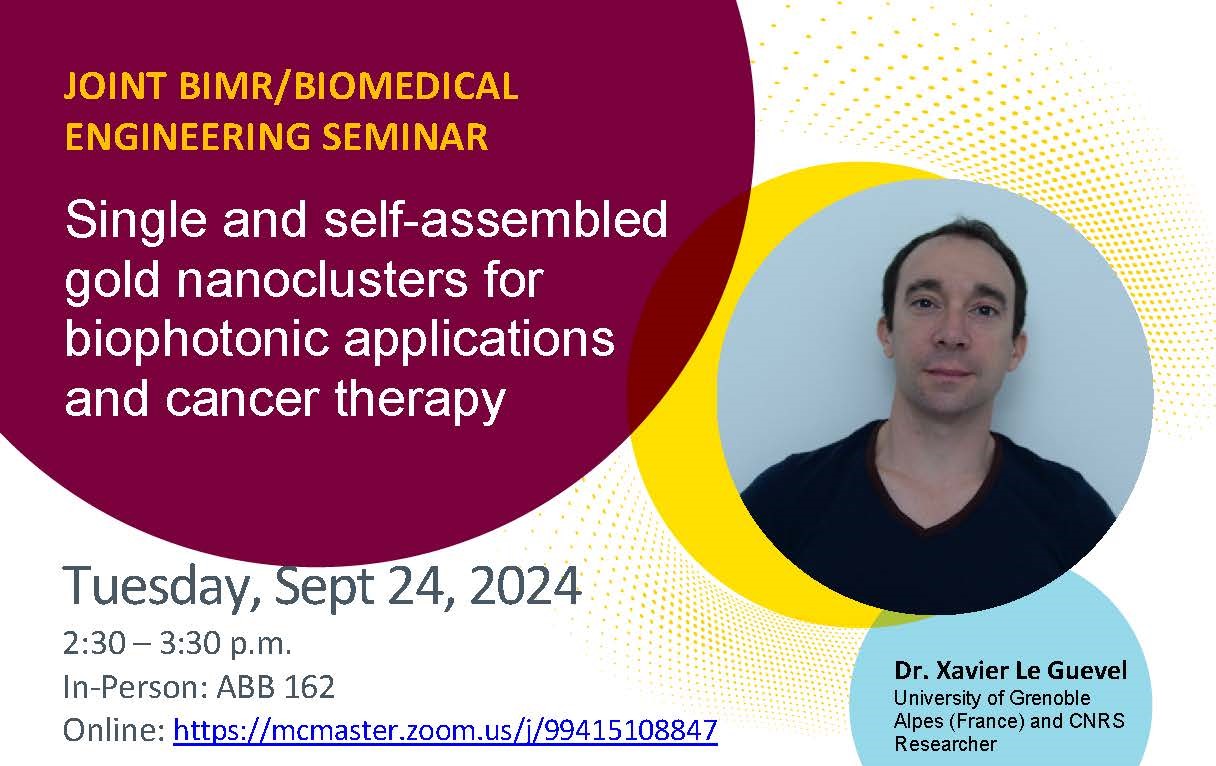Single and self-assembled gold nanoclusters for biophotonic applications and cancer therapy
Sep 24, 2024
2:30PM to 3:30PM

Date/Time
Date(s) - 24/09/2024
2:30 pm - 3:30 pm
Categories
Dr. Xavier Le Guevel
University of Grenoble Alpes (France) and CNRS Researcher
Among the large library of organic and inorganic nanosystems, noble metal nanoclusters—primarily gold—are ultra-small particles with sizes below 3 nm. These nanoobjects are highly attractive in the fields of biophotonics and biomedicine due to their unique molecular-like properties, which include tunable photoluminescence ranging from UV to near-infrared, chirality, enzymatic reactivity, and photo/radiotoxicity1. These properties can be harnessed for diagnostic and therapeutic purposes and are closely linked to the nanoclusters’ size and the precise design of ligand engineering2. Moreover, recent studies have reported new optical properties, such as striking enhancements in absorbance and photoluminescence, when these metal nanoclusters are organized in one, two, or three dimensions. This opens up promising avenues for applications in optoelectronics, biosensing, and nanomedicine3, 4.
We design biocompatible gold nanoclusters at the single level using short organic molecules or peptides and at assembly levels using polymers, and biomolecules (DNA, protein) as matrices. We investigate their morphology, physico-chemical and optical properties.
In the context of cancer therapy, we develop these nanosystems to enhance their targeting of cancer cells and to induce cell death through combined strategies, including siRNA delivery and light/X-ray stimulation. We study the interactions of these nanosystems in artificial models as well as in 2D and 3D cancer cell cultures (including lung, breast, and glioblastoma). Additionally, we assess their biodistribution and therapeutic efficacy in tumor-bearing mice.5-9.
We are also exploring the development of in vivo imaging techniques within the near-infrared window between 1000 and 1700 nm, known as NIR-II or SWIR (Shortwave Infrared). This optical detection method enables high-resolution visualization at sub-centimeter depths for various applications, including vascular disorders, intermittent hypoxia, and tumor angiogenesis. Advances in instrumentation design, the formulation of bright and biocompatible contrast agents, including gold nanoclusters, and imaging processing techniques (such as Monte Carlo restoration and deep learning) have demonstrated the potential to non-invasively quantify vascular morphology, vessel permeability, and angiogenesis in real-time in small animal models.”3, 10-12.
References
- N. Sharma, W. Mohammad, X. Le Guével and A. Shanavas, Chemical & Biomedical Imaging, 2024, 2, 462-480.
- V. Bona?i?-Koutecký, X. Le Guével and R. Antoine, ChemBioChem, 2022, n/a, e202200524.
- Z. Yu, B. Musnier, K. D. Wegner, M. Henry, B. Chovelon, A. Desroches-Castan, A. Fertin, U. Resch-Genger, S. Bailly, J.-L. Coll, Y. Usson, v. josserand and X. Le Guével, ACS Nano, 2020, 14, 4973-4981.
- A. Yahia-Ammar, D. Sierra, F. Mérola, N. Hildebrandt and X. Le Guével, ACS Nano, 2016, 10, 2591-2599.
- I. Moskalevska, V. Faure, L. Haye, M. Mercey-Ressejac, A. K. Dey, B. Chovelon, L. K. Soro, L. J. Charbonnière, A. Reisch, A. S. Klymchenko, P. N. Marche, J.-L. Coll, Z. Macek Jilkova and X. le Guével, International Journal of Pharmaceutics, 2023, 630, 122439.
- Y. Kong, D. Santos-Carballal, D. Martin, N. N. Sergeeva, W. Wang, G. Liu, B. Johnson, B. Bhayana, Z. Lin, Y. Wang, X. Le Guével, N. H. de Leeuw, D. Zhou and M. X. Wu, Materials Today, 2021, 51, 96-107.
- M. Broekgaarden, A.-L. Bulin, E. Porret, B. Musnier, B. Chovelon, c. ravelet, L. Sancey, H. Elleaume, P. Hainaut, J.-L. Coll and X. Le Guevel, Nanoscale, 2020, 12, 6959-6963.
- X. Le Guevel, M. Henry, V. Motto-Ros, E. Longo, M. I. Montanez, F. Pelascini, O. de La Rochefoucauld, P. Zeitoun, J. L. Coll, V. Josserand and L. Sancey, Nanoscale, 2018, 10, 18657-18664.
- E. Porret, L. Sancey, A. Martín-Serrano, M. I. Montañez, R. Seeman, A. Yahia-Ammar, H. Okuno, F. Gomez, A. Ariza, N. Hildebrandt, J. B. Fleury, J. L. Coll and X. Le Guével, Chemistry of Materials, 2017, 29, 7497-7506.
- A. A. Simon, L. Haye, A. Alhalabi, Q. Gresil, B. M. Muñoz, S. Mornet, A. Reisch, X. Le Guével and L. Cognet, Advanced Science, 2024, n/a, 2309267.
- X. Le Guével, V. Josserand, O. Harki, V. A. Baulin, M. Henry and A. Briançon-Marjollet, American Journal of Physiology-Heart and Circulatory Physiology, 2024, 326, H900-H906.
- V. A. Baulin, Y. Usson and X. Le Guével, Journal of Biophotonics, 2021, n/a, e202100102.
Bio:
Dr Xavier Le Guével obtained his PhD in 2006 in Chemistry from the University of Tours/ French Alternative Energies and Atomic Energy Commission (France). Following this, he did some postdoctoral fellowships in the fields of optical waveguides (Rome, Italy), biosensors (Dublin, Ireland) and pharmaceutical nanotechnology (Saarbrücken, Germany) between 2006 and 2010 before starting as an independent researcher at the Nanomedicine Centre Bionand in Malaga (Spain) in close collaboration with the department of Allergy at Malaga hospital.
Since 2016, XLG has been a CNRS researcher, and then CNRS research director since 2023 at the Institute for Advanced Biosciences at the University of Grenoble Alpes (France).
XLG was PI on various private and public funded projects (Plan cancer, ARC, ANR, LCC, Merck Serono, Carlos Tercero…) dedicated to the use of nanomaterials for diagnosis and therapy. His work focuses on the development of new nanosystems such as metal nanoclusters and optical instruments for medical applications and more specifically for cancer treatment and diagnosis from the fundamental research to pre-clinical applications.
In-Person: ABB 162
Online: https://mcmaster.zoom.us/j/99415108847
Meeting ID: 994 1510 8847
Passcode: 393626

